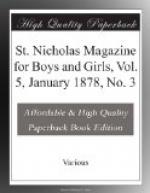Screens covered with pictures cut from magazines and illustrated newspapers are very much liked by boys and girls, and by some of their elders.
A COUVRE-PIED.
This is a large oblong in loosely knitted double zephyr wools, and is made double, dark brown on one side, for instance, and pale blue on the other. The two are united with a border in open crochet of the brown, laced through with light blue ribbon, which is finished at each corner with a loosely tied bow and ends. The couvre-pied, as the name indicates, is meant to cover the feet of a person who lies on a sofa, and is an excellent present to make to an elderly or invalid friend.
TILE OR CHINA PAINTING.
Don’t be frightened at the word, dears. China-painting is high art sometimes, and intricate and difficult work often, but it is quite possible to produce pretty effects without knowing a great deal about either china or painting. Neither are the materials of necessity expensive. All that you need, to begin with, are a few half tubes of china or mineral paints, which cost about as much as oil colors, four or five camel’s-hair brushes, a palette-knife, a small phial of oil-of-lavender, and another of oil-of-turpentine, a plain glazed china cup or plate or tile to work on, and either a china palette or another plate on which to rub the paints. For colors, black, capuchine red, rose-pink, yellow, blue, green and brown are an ample assortment for a novice and for purposes of practice. We would advise only two tubes, one of black and one of rose pink, which are colors that do not betray your confidence when it comes to baking. For the chief difficulty in china-painting is that to be permanent the work must be “fired,”—that is, fused by a great heat in a furnace,—and it requires a great deal of experience to learn what the different tints are likely to do under this test. Some colors—yellow, for instance—eat up, so to speak, the colors laid over them. Others change tint. Pinks and some of the greens grow more intense; white cannot be trusted, and mixing one paint with another, as in oils, can only be done safely by experts. It is well, therefore, to begin with two simple colors, and you will be surprised to see how much may be done with them. (See “Hollenberry Cup,” in ST. NICHOLAS for May, 1877, page 458.) A cup of transparent white china, the handle painted black, a Japanese-looking bough with black foliage and pink blossoms thrown over it, and a little motto, has a really charming effect. But be sure to put on the pink very pale, and the black, not in a hard, solid streak, but delicately, to suggest shading from dark to light, or the result of the baking will be disappointment.




